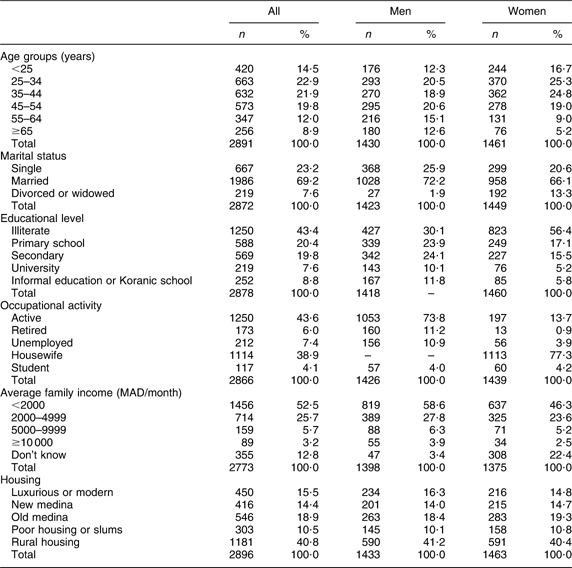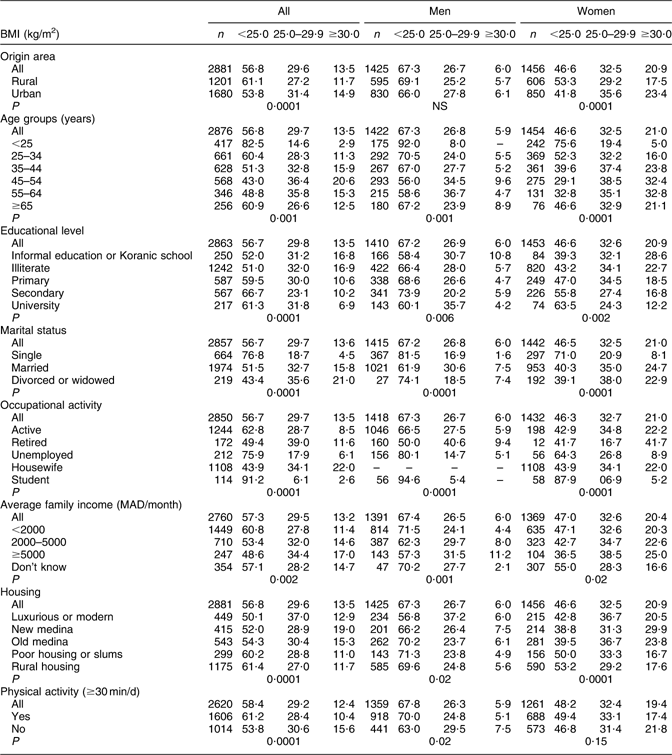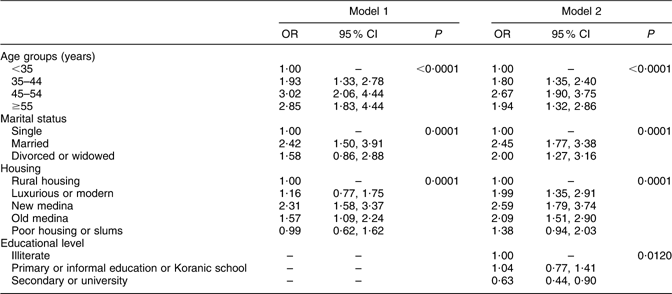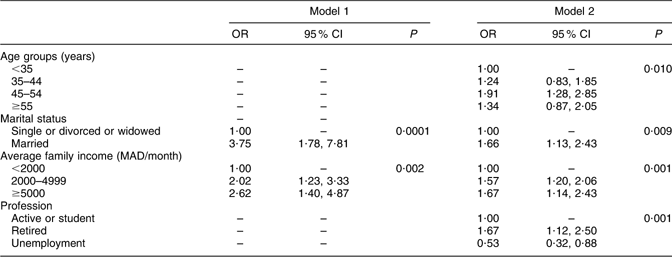Obesity and overweight constitute a major public health problem and their prevalence is increasing at an alarming rate worldwide(1). Obesity is a major risk factor for the development of certain chronic diseases and has been related to some hormone-dependent cancers(Reference Pi-Sunyer2, Reference Khan and Bowman3). Many environmental factors such as lifestyle and poor diet(Reference Chen, You and Zhao4, Reference Shepard, Weil and Sharp5), age patterns(Reference Bartali, Benvenuti and Corsi6), socio-economic factors(Reference Heitmann7) and a lack of physical activity(Reference Lindstrom, Isacsson and Merlo8) play an important role in the onset of obesity(Reference Bouchard9). Changes in diet and inactivity patterns in transitional societies are fuelling the obesity epidemic(Reference Popkin10, Reference Popkin and Gordon-Larsen11).
Socio-economic status (SES) as a marker for lifestyle behaviours is inversely associated with overweight and obesity in developed societies(Reference McLaren12) and positively associated in developing countries(Reference Monteiro, Moura and Conde13). However, the relationship between SES and obesity is complex and poorly understood in many countries.
In North African countries, obesity is a growing problem, especially as female fatness is a cultural symbol of beauty, fertility and prosperity(Reference Monteiro, Moura and Conde13, Reference Mokhtar, Elati and Chabir14). These countries are undergoing a demographic transition(Reference Popkin15) and economic development, which have some implications for lifestyle, diet and related health conditions, especially obesity. However, there are some exceptions, such as Tunisia, where the prevalence of obesity becomes quite similar to that found in European countries, especially in women with higher SES, who prefer a slimmer body such as that in Western societies(Reference Kamoun, Hajem and Imen16, Reference Tlili, Mahjoub and Lefèvre17). The aetiology of obesity in North Africa is still not well understood and few studies shed any light on its development among women(Reference Mokhtar, Elati and Chabir14).
Morocco is a North African country with Mediterranean climate and a population of 30 million. During the past 50 years, the Moroccan population has been undergoing an epidemiological transition(Reference Jroundi18). A marked shift was also documented in dietary patterns and lifestyle as part of the nutritional transition. This was associated with an increase in overweight and obesity(Reference Benjelloun19). Many studies have been interested in the prevalence of obesity in the general population and in particular groups(Reference Rguibi and Belahsen20–Reference Tazi, Abir-Khalil and Chaouki23). In the most recent national survey in the year 2000, overweight and obesity were found to occur among 39·3 % and 13·2 %, respectively, of individuals aged 20 years and above(Reference Tazi, Abir-Khalil and Chaouki23) but their association with SES remains poorly understood. The objective of the present study was to estimate the prevalence of overweight and obesity in a national representative Sample of Moroccan adults and describe its relationship to SES and the lifestyle of subjects.
Population and methods
Study design
The present cross-sectional study was carried out in May 2008 on a national random sample of the Moroccan population aged 18 years and above. Sampling procedures were as follows: sample size was calculated on the basis of 15 % risk factor prevalence, 2 % precision, 95 % CI and a cluster effect of 2; and sample size was estimated at 2448 and rounded to 3000 persons to compensate for people refusing to take part or being absent during the survey. The people to be surveyed were selected at random from 150 communes, in clusters of twenty persons per commune. A cluster was defined as a neighbourhood in an urban area and a locality in a rural area. One cluster was selected at random from each commune included in the survey and one person aged 20 years or above from each household of the cluster was selected at random. The total cluster selection was done proportionally to the distribution of the Moroccan population in urban and rural areas (53 and 47 %, respectively)(24). Pregnant women and bed-ridden terminally ill people, as well as the mentally ill, were considered ineligible. A person selected at random was not replaced in the case of absence or refusal to take part. Exclusion criteria included individuals unable to provide the requested information or written consent to participate in the study.
Survey procedure
The interviewers were first trained to the survey in order to standardize the data collected and the anthropometric measurements. They were teamed up in pairs (one man and one woman) and were supervised by members of the survey planning team. The data were collected in the subjects’ respective homes during a personal interview. The questionnaire included questions on demographics (age, sex, place of residence, educational level), SES (declared total monthly income of all the members of the household, profession, etc.) and physical activity, which were assessed by means of a detailed frequency questionnaire, including weekdays and weekends. Usual physical activity in work, method of going to and from work, leisure time and sports practice were considered in the questionnaire.
Variables studied
Anthropometric measurements
The following measurements were performed: body weight, height, BMI (kg/m2). Body weight was measured using bathroom scales, with the person wearing light clothes and no shoes. Body weight was expressed in kilograms. The bathroom scales were calibrated before and during the study. Size was measured using a height gauge with the subject standing barefoot. Size was expressed in centimetres.
BMI, corresponding to the person’s weight divided by the square of the person’s height (kg/m2), was used to define underweight (BMI < 18·5 kg/m2), normal weight (BMI ≥ 18·5 and <25·0 kg/m2), overweight (BMI ≥ 25·0 and <30·0 kg/m2) and obesity (BMI ≥ 30·0 kg/m2) according to WHO recommendations(1).
Sociodemographic and lifestyle variables
Among determinants of SES, monthly income was used as a class variable into the following categories: <2000 MAD corresponding about to the guaranteed minimum wage, 2000–4999 MAD, 5000–9999 MAD and ≥10 000 MAD (equivalent currency exchange is: 1 MAD = 0·09 €). Given the small number of the two latter classes (5000–9999 and ≥10 000 MAD/month), they were grouped in the unvariate analysis. Profession was categorized into five classes: active, retired, unemployed, housewife and student. We also grouped the highest level of education achieved into the following categories: university, secondary level, primary level, Koranic school or informal education and illiterates. In the multivariate analysis, educational level was grouped into three categories (illiterates, 0 school years; primary level and Koranic school or informal education, ≤6 school years; university and secondary level, >6 school years). Ages were grouped into 10-year segments ranging as follows: <25, 25–34, 35–44, 45–54, 55–64 and ≥65 years or older. Marital status was also grouped into three classes: married, single, divorced or widowed. Physical activity was defined according to WHO guidelines, which recommended that at least 30 min of regular, moderate or intense physical activity on most days reduces the risk of CVD and diabetes, colon cancer and breast cancer(1). A person was therefore considered as active if he/she performed at least 30 min of physical activity per day. Housing group was classified according to criteria used previously(25) into five categories: luxurious, modern, new medina, old medina, poor housing or slums and rural housing.
Statistical analysis
Summary statistics were used to describe the study population. Results were reported as percentage and mean and standard deviation. The association between obesity and the determinant factors considered was researched through univariate analysis and then through multiple binomial logistic regression with being obese as the dependent variable in the first model (model 1) and being obese or overweight as the dependent variable in the second model (model 2). Factors associated with inclusion at α <10 % in univariate analysis were included in the initial multivariate logistic model. Manual descending multivariate logistic regressions were carried out. Factors associated with inclusion at α <5 % remained in the final multivariate logistic model. Dummy categorical variables were used in logistic regressions. Univariate and multivariate regression analyses were carried out separately for men and women. Adjusted OR and 95 % CI are presented for both sex groups. All statistical analyses were performed using the Statistical Package for Social Sciences statistical software package version 17·0 (SPSS Inc., Chicago, IL, USA).
Results
In total, out of the 3000 people selected, 2891 (96·5 %) took part in the survey, including 1430 men (49·5 %) and 1461 women (50·5 %). People who are not included in the survey had refused to participate or were absent (3·5 %). The sample description according to sex is shown in Table 1.
Table 1 Main demographic and socio-economic characteristics according to gender

Sample of the adult Moroccan population, 2008.
The overall prevalence of obesity was 13·5 %, but was much higher in women than in men (20·9 % v. 6·0 %, P < 0·0001; Table 2). This prevalence was significantly higher in urban areas (14·9 %) than rural areas (11·7 %; P < 0·001), but the difference was significant only in women. The overall prevalence of overweight was 29·9 % (32·9 % in women v. 26·8 % in men; P < 0·0001).
Table 2 BMI distribution by sociodemographic and lifestyle characteristics and gender

Sample of adult Moroccan population 2008.
P for global χ 2 tests.
In univariate analyses (Table 2), the prevalence of obesity increased with age until 64 years in women, but in men the highest prevalence was observed between 45 and 54 years of age. The prevalence of overweight (not including obesity) increased with age until the age of 64 years in men and until the age of 54 years in women. According to educational level, the prevalence of obesity and overweight decreased from illiterate to university level in women, whereas in men the prevalence of obesity varied little with educational level. The prevalence of overweight increased up to primary level of schooling in women. In men, overweight was much more frequent in those with a university level of education and in persons attending only informal education or Koranic school. Married women and men had the highest prevalence of obesity. In both genders, single persons had the lowest prevalence of both overweight and obesity.
Within the five occupational groups and according to sex, retired subjects were more often obese or overweight than those with other occupational activities (total prevalence 50·0 % and 58·4 % in men and women, respectively), which may be explained by their older age: 83·7 % of the retired subjects were 55 years old and above v. 16·2 % of the active persons (P < 0·0001; Table 2).
A positive relationship was found between the prevalence of obesity and total family income in both genders; as income of the family increased, the prevalence of obesity increased.
According to housing, the prevalence of obesity and overweight increased with the quality of housing. A higher prevalence was observed among individuals who lived in new or old medina or in luxurious or modern houses than in those who lived in poor housing or in slums. The same trend was observed in the whole population and separately in men and women.
The number of persons living in the same house, as an indirect indicator of SES, was not different between obese (mean 5·9; sd 3·0) and non-obese persons (mean 6·1; sd 3·0). The same results were found separately in men (mean 6·2; sd 3·0) and in women (mean 5·7; sd 2·9) and also when we adjusted for the type of housing or on average family income.
The prevalence of obesity appeared to be lower among subjects who practised at least 30 min of physical activity per day than in the others (10·4 % v. 15·6 %, P < 0·0001). The same trend was observed separately in men and in women even if it was not significant in women. But this association disappeared after adjusting for average family income and for the other socio-economic factors.
After correction for possible confounding factors including all demographic and socio-economic factors in multivariate regression models separately in men and women, the retained variables in the final manual descending multivariate logistic regression models differed between men and women. However, in women as in men, physical activity did not remain a significant correlate of obesity or overweight in the multivariate models.
In women, physical activity and occupation were no longer associated with obesity in the final model (Table 3). Age remained strongly associated with obesity with the highest risk in individuals aged 45–54 years compared to those aged <35 years. According to marital status, married women remained more prone to obesity than single and divorced or widowed women. However, both married and divorced or widowed women were at higher risk of overweight including obesity. Housing was another independent correlate of obesity with a higher risk in women living in new medina. Similar results were observed in the estimation of adjusted OR for obesity or overweight with, in addition to the previous factors, a significantly decreased risk in women with a higher educational level.
Table 3 Adjusted OR for obesity or overweight in women

Sample of adult Moroccan population, 2008 (n 1440).
Model 1: obesity as a dependent variable.
Model 2: obesity or overweight as a dependent variable.
Given the small number of divorced or widowed men (n 27) this category was grouped with the singles in multivariate analyses (Table 4). Age, education and occupation were no longer associated with obesity in men in the final multivariate model. Married men were more prone to obesity than single, divorced or widowed individuals. Average family income was a strong correlate with increasing risk with higher family income, the highest risk being associated with an income of ≥5000 MAD/month. When the dependent variable was ‘obesity or overweight’, age group and occupation were both independently associated with obesity or overweight with the highest risk in retired men. Conversely, risk was significantly decreased in unemployed men.
Table 4 Adjusted OR for obesity or overweight in men

Sample of adult Moroccan population, 2008 (n 1325).
Model 1: obesity as a dependent variable.
Model 2: obesity or overweight as a dependent variable.
Discussion
In the present study, we investigated the relationship between obesity and socio-economic factors within a sample from the Moroccan population aged 18 years and above. The overall prevalence of obesity and overweight was 13·5 % and 29·9 %, respectively, and higher in women and urban areas compared to men and rural areas. The prevalence of obesity in Morocco has increased from 1·6 % in 1984 to 4·3 % in 1998 in men and from 6·4 % in 1984 to 16·0 % in 1998 in women aged 20 years and above. In addition, it increased from 5·5 % in 1984 to 12·2 % in 1998 in the urban population and from 2·6 % in 1984 to 7·4 % in 1998 in the rural population(Reference Benjelloun19).
Gender difference in the prevalence of obesity was found to be highly significant in our population and there are similar findings in previous studies in Morocco(Reference Tazi, Abir-Khalil and Chaouki23) and in other countries(Reference Hajian-Tilaki and Heidari26, Reference Xu, Yin and Zhang27).
Age was strongly associated with obesity in women, as previously reported(Reference Peixoto, Benício and Jardim28). This association between obesity and age can be explained, in part, by parity and postmenopausal status(Reference Tufano, Marzo and Enrini29). The reduced risk of obesity in younger women may reflect a possible shift in the burden of obesity in women, from the positive association observed in most studies from sub-Saharan Africa(Reference Rguibi and Belahsen20, Reference Lahmam, Baali and Hilali21) to the inverse association reported from developed countries. Therefore, younger women, who are more likely to be educated, adopt lifestyles that are less prone to obesity in response to their exposure to the cultures of more developed countries.
Obesity was inversely associated with educational level in our study, which remained after adjustment for confounding variables in women. This may be due to a healthier lifestyle in individuals who have been educated to a higher level and is in accordance with other recent studies(Reference Hajian-Tilaki and Heidari30).
Several studies have underlined the importance of socio-economic factors and physical activity(Reference Martinez, Kearney and Kafatos31, Reference Aal-Isa32). Our finding showed that family income was strongly and positively associated with obesity, especially in men. In women, a strong association between housing and obesity or overweight was observed. Obesity and overweight were more common among the women living in luxurious or modern housing and in new or old medina. This may be explained by lifestyle factors including level of physical activity. Women living in more comfortable houses and urban areas probably spend less time walking and doing heavy housework than those living in poor housing or in rural areas. Similarly, higher income may provide access to more abundant dietary resources and lifestyle choices. Therefore, wealthier men may be consuming larger portions of food because they can afford to do so. Concerning physical activity, our study showed that it decreased with the average family income (73·1 % in <2000, 67·5 % in 2000–4999 and 44·9 % in ≥5000 MAD/month; P < 0·0001). Therefore, the wealthier men walked less often because they owned and used cars frequently. Men with higher income did not do chores that were probably physically demanding because they could afford to employ others. Therefore, they were probably expending less energy. They were also spending greater time at work, which was often sedentary, and hence had less time to participate in leisure-time physical activity. People in the highest socio-economic classes were more prone to adopting a Western way of life, including more meals taken in restaurants or fast foods, and more time spent watching television or working on computers. However, physical activity was not significantly correlated with obesity or overweight in the multivariate models, perhaps because of a lack of accuracy of its measurement in two classes only. As in other studies(Reference Kahn, Williamson and Stevens33, Reference Sobal, Rauschenbach and Frongillo34), we evidenced a significant difference in the prevalence of obesity with marital status in univariate analysis, with more obesity in married, widowed and divorced individuals compared to single persons. This association remained significant in the multivariate analysis in both genders. This may be explained by access to more abundant food and rich dishes. Furthermore, married, widowed or divorced persons were older than the single persons (24·7 % and 47·0 % among married and widowed or divorced, respectively, were 55 years old and above v. 1·1 % among single persons; P < 0·0001). Moreover, it is very likely that the cultural preference for female plumpness coupled with physical and cultural barriers to physical activity makes the difference(Reference Rguibi and Belahsen20).
Housewives and retired persons were the most frequently obese group in our study compared to those who were employed, unemployed and students. These results are concordant with the results of previous studies(Reference Hajian-Tilaki and Heidari26). But this association disappeared after correction for confounding variables, in particular older age.
The main limitation of the present study is its cross-sectional design. We cannot therefore demonstrate causality of the associations with the factors evidenced in the present study. The second limitation was a recall bias, especially for income and education level that might be over- or underestimated because data were collected by direct interview. Furthermore, given the lack of data on number of pregnancies and engagement in sport in the present study, we could not ascertain the impact of these variables on overweight and obesity. In particular, a more precise evaluation of the time spent on various professional, household and recreational activities would have allowed a better estimation of physical activity. However, the strength of this nationwide study was that it was representative of the whole Moroccan population since the prevalence of sociodemographic factors was similar to that reported in the last general census of habitat and population in 2004(24). Our findings are in accordance with two previous studies in Morocco, one with a sociological approach of Moroccan women’s household roles in relation to obesity(Reference Batnitzky35) and the other one conducted in a specific group of Sahraoui women(Reference Rguibi and Belahsen36). Another strength was the direct measurement of anthropometric data.
In conclusion, the present study contributes to understanding the relationship between the socio-economic factors and obesity and overweight in the Moroccan population. Higher income and better living conditions associated with higher SES are the main risk factors of overweight and obesity. Recognizing these factors may facilitate planning of preventive programmes for reducing obesity in the targeted groups in this society.
Acknowledgements
The present study was funded by ‘Association Lalla Salma de Lutte contre le Cancer – Maroc’. The authors have no conflict of interest. K.E.R. contributed to the conception and design, acquisition of data, analysis and interpretation of data and was involved in drafting the manuscript; C.N. contributed to the conception and design, interpretation of data, was involved in revising the manuscript critically and gave final approval of the version to be published. A.Z. contributed to the conception and design of data; R.B. contributed to the conception and design of data. M.B. made substantial contributions to conception and design of data; P.B.G. was involved in drafting the manuscript and gave final approval of the version to be published. Special thanks to Dr T. Norat (Department of Epidemiology and Public Health, Imperial College London, UK) for reviewing the manuscript.






